by Bruce Wells | Apr 18, 2025 | Petroleum Pioneers
Friendship monument dedicated in 1926 preserves the history of Osage oil leases.
Colonel Elmer Ellsworth (his real name) Walters was the most famous auctioneer in all of Oklahoma history. In 1912, the Osage Indians hired him to auction mineral rights from their petroleum-rich reservation. By 1920, they had awarded him a gold medal for his skillful sales of Osage oil leases.
Walters was paid $10 a day while earning the tribe millions of dollars while working beneath a giant elm tree in Pawhuska. In April 1926, his Osage friends and residents dedicated a “Bond of Friendship” monument in Walters’ nearby hometown of Skedee.

Newspaper ad courtesy of Colonel Walters’ great-great-granddaughter Hope Litvinoff. Her grandmother in 1926 helped unveil a statue in Skedee, Oklahoma, honoring Walters and the chief of the Osage Nation.
Born in Adrian, Illinois, in 1865, Walters was one year old when his parents moved to the Cherokee Nation, Indian Territory. He was named in honor of Col. Elmer Ephraim Ellsworth of the 11th New York Volunteers — the first Union officer killed at the start of the Civil War (shot while removing the Confederate flag from the roof of a hotel in Alexandria, Virginia).
Although Walters became a deputy U.S. marshal at 19, he began gaining distinction as an auctioneer. He sold livestock, real estate and mineral leases in 2,250-square-mile Osage County.
Million Dollar Elm
Beginning in 1912, Walters sold Osage mineral leases in 160-acre blocks based on “headrights” from a 1906 tribal population count. In Pawhuska, between the Osage council house and the county courthouse, Walters called the auctions while standing in the shade of what became known as the “Million Dollar Elm.”
The bidders for the leases were a who’s who of leading Oklahoma independent producers. E.W. Marland biographer John J. Mathews quotes one impressed onlooker: “You could stand on the edge of the crowd and see two or three of the biggest names in America squatting there on the grass, as common as an old shoe, and when they raised their hands it meant millions. That’s a fact!”

Another onlooker described hundreds of spectators and reporters who gathered to watch the bidding. Walters proved so effective at “extracting millions from the silk pockets of such newly minted oil barons as Frank Phillips, E.W. Marland, and William G. Skelly” that the Osages awarded him a medal.
“On February 3, 1920, before that day’s bidding began, the Osage tribe presented Walters with a medal to show their appreciation for all the wealth he’d drummed up for them in the shade of the Million Dollar Elm,” the witness reported.
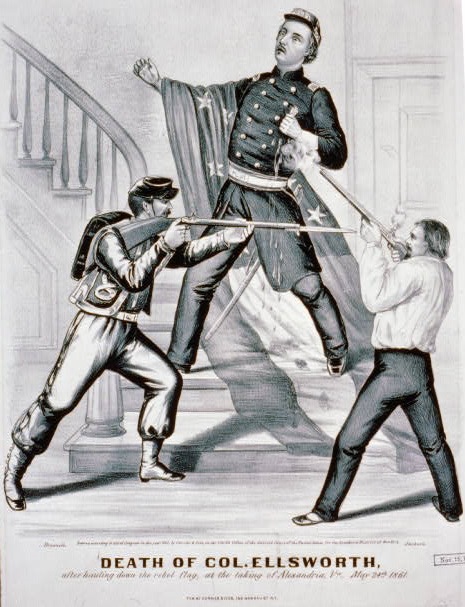
Born in 1865, Colonel E.E. Walters wasn’t actually a Colonel. He was named in honor of the first Union officer killed in the Civil War, complete with rank. Currier and Ives engraving, 1861. Image courtesy Library of Congress.
By 1922, the National Petroleum News proclaimed that Walters had “Sold 10 Times As Much Property Under Hammer As Any Other Man” and his friends, the Osage, became “the richest people in the world.”
Beneath the Pawhuska elm on March 18, 1924, Walters secured a bid of $1,995,000 for one 160-acre tract. It was the highest price paid at that time, according to the Oklahoma Historical Society. Walters reportedly received more Osage gifts, including a diamond-studded badge and a diamond ring for his auctions of Osage oil leases.
Dark Side of Headrights
Sudden great wealth for the Osage people brought a bloody criminal conspiracy of unsolved murders that left dozens of Osage men, women, and children dead — killed for the headrights to their land.
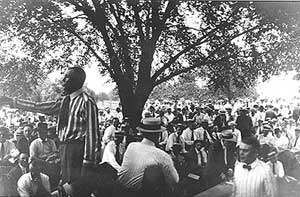
In the early 1920s, Colonel E.E. Walters stood in the shade of a soon-famous Elm tree to auction mineral leases, including a $2 million bid for a single 160-acre Osage lease. Detail from a photo in Oil! Titan of the Southwest by Carl Coke Rister, 1949.
“Osage mineral leases earned royalties that were paid to the tribe as a whole, with each allottee receiving one equal share, or headright, of the payments, noted Oklahoma Historical Society historian Jon D. May in Osage Murders.
“A headright was hereditary and passed to a deceased allottee’s immediate legal heir,” May added. “One did not have to be an Osage to inherit an Osage headright.”
Estimates vary, but at least 24 Osage Indians died violent or suspicious deaths during the early 1920s, when con men, bootleggers and murderers began a “Reign of Terror.”

William K. Hale was one of the worst. He was accused of repeatedly orchestrating murders, tried four times, and finally convicted of a single killing. The best-seller 2018 book Killers of the Flower Moon by journalist David Grann investigated the disturbing and tragic stories.
The New Yorker staff writer’s award-winning book would be adapted into a $200 million movie directed by Martin Scorsese, who acquired book rights in July 2017.
Sadly, at the time most Oklahoma news media ignored the reservation’s murders — and the murderers. Newspapers there and around the country instead featured scandalous stories of incredible Osage wealth squandered on Pierce-Arrows and gaudy fashion. As Osage Indians died, reporters mocked the tribe with sarcasm and caricatures.
In his 1994 book, Bloodland: A Family Story of Oil, Greed and Murder on the Osage Reservation, Washington Post journalist Dennis McAuliffe noted little wonder that, “this period in our history hardly dances with awareness.”
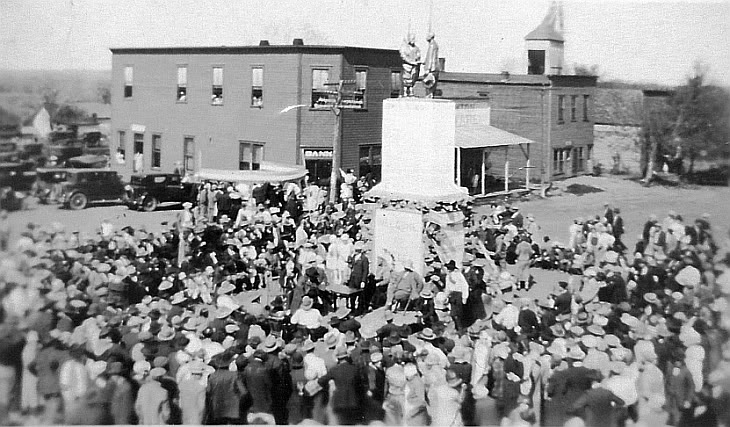
On April 22, 1926, hundreds gathered in Skedee, Oklahoma, for the unveiling of the 25-foot Bond of Friendship monument honoring the chief of the Osage Nation and the state’s greatest auctioneer of mineral rights.
As a result of the Osage murders, on February 27, 1925, the U.S. Congress passed the “Osage Indians Act of 1925,” a law prohibiting non-Osages from inheriting headrights of tribal members possessing more than one-half of Osage blood.
According to the Osage Nation, in 2022, “approximately 26 percent of all headrights are owned by non-Osage individuals, churches, universities, and other non-Osage institutions who can freely bequeath such interests to any person or entity the non-Osage chooses.
Bond of Friendship
On April 22, 1926, hundreds gathered in Walter’s longtime home of Skedee for the dedication of a 25-foot Bond of Friendship monument. The unveiling revealed “painted bronze” statues of Walters and the chief of the Osage Nation shaking hands on a two-tiered sandstone and concrete base.

Like the town, the Bond of Friendship of Skedee, Oklahoma, has deteriorated since 1926. Photo courtesy the Library of Congress.
The friendship between Osage Chief (phonetically) Wah-she-hah and Walters left a statue in the Skedee town square. Wah-she-hah translates to Star-That-Travels in the Osage language — but history and visitors to the Skedee statue remember him as Chief Bacon Rind.
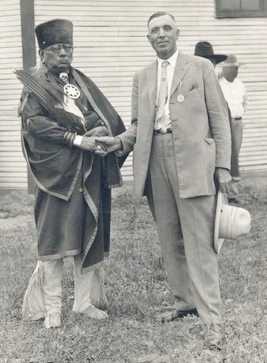
Osage Chief Bacon Rind and Colonel E.E. Walters in an undated photo.
Still standing in Skedee, the 1926 sculpture depicts Osage Chief Bacon Rind wearing his traditional otter-skin cap and a cloak. Walters wears a suit with trousers tucked into his boots and holds a hat in his left hand. At the statue’s unveiling, the popular “auctioneer of the Osage Nation” had sold $157 million in lease sales for his friends. But it wasn’t all good news.

By the early 2020s, the Skedee Bond of Friendship monument began showing its age. The legacy of the once famous lease auctioneer and the Osage friendship provided some merriment for at least one contributor to Roadside America:
“The lesson imparted here is that white and red can be harmonious — if you just add a little green…Atop a blocky concrete pillar stands the Chief and the Colonel, facing each other, shaking hands. The work is primitive for such well-oiled honorees…while the Chief and the Colonel appear to be made of Play-Doh spray-painted silver.”

Although a traditionalist in customs, Chief Bacon Rind’s leadership earned his people millions from oil and natural gas resources.
However, the Osage Chief Bacon Rind, “a statuesque man at six feet four inches,” at one time was among the most photographed of all Native Americans. The Works Progress Administration noted the chief frequently posed for the prominent artists of the day “and created an image of the romantic ideal of the American Indian.”
Chief Bacon Rind died in 1932 and Walters followed in 1946. The population of Skedee peaked in 1910; a century later fewer than 50 residents remained. The tall but weathered monument remains in the center of town.
Walters, an amateur poet, had his hopes for the future carved into his hometown monument’s base:
…I will build for them a landmark,
That the coming race may see,
All the beauties of the friendship,
That exists ‘tween them and me…
And explain it to grandchildren,
as they sit upon their knee.
Preserving Osage Oil Stories
In 2018, an Osage writer decided to look deeper into Walter’s life and times. Already an author of several books about Osage history, Anna Marie Jefferson a year later published Colonel E. Walters: Auctioneer for the Osage Lease Sales During the early 20th-Century. Her research revealed many local newspaper accounts and rare images from his career.

Osage writer Anna Marie Jefferson published her book about Colonel Walters in 2019.
Jefferson, who grew up in Osage County, remembered visiting the statue as a child in neighboring Pawnee County. “As an Osage (Sac and Fox/Pawnee as well) I was unaware of who Colonel E. Walters was, the man on top of the memorial.”

Familiar with Osage leader Bacon Rind, Jefferson began researching the life of Walters and his famed long career as a skilled auctioneer.
“When traveling the Osage, sometimes one needs to go just beyond the county lines to find early Osage Nation,” she explained in her book’s introduction. “Such is the case with the Bond of Friendship monument in the small town of Skedee, Oklahoma.”
_______________________
Recommended Reading: The Underground Reservation: Osage Oil (1985); Killers of the Flower Moon: The Osage Murders and the Birth of the FBI
(1985); Killers of the Flower Moon: The Osage Murders and the Birth of the FBI (2018); Colonel E. Walters: Auctioneer for the Osage Lease Sales During the early 20th-Century (2019). Your Amazon purchase benefits the American Oil & Gas Historical Society. As an Amazon Associate, AOGHS earns a commission from qualifying purchases.
(2018); Colonel E. Walters: Auctioneer for the Osage Lease Sales During the early 20th-Century (2019). Your Amazon purchase benefits the American Oil & Gas Historical Society. As an Amazon Associate, AOGHS earns a commission from qualifying purchases.
_______________________
The American Oil & Gas Historical Society (AOGHS) preserves U.S. petroleum history. Please become an AOGHS annual supporter and help maintain this energy education website and expand historical research. For more information, contact bawells@aoghs.org. © 2025 Bruce A. Wells.
Citation Information – Article Title: “Million Dollar Auctioneer.” Authors: B.A. Wells and K.L. Wells. Website Name: American Oil & Gas Historical Society. URL: https://aoghs.org/petroleum-pioneers/million-dollar-auctioneer. Last Updated: April 18, 2025. Original Published Date: March 27, 2015.
by Bruce Wells | Feb 24, 2025 | This Week in Petroleum History
February 24, 1938 – First Nylon Bristle Toothbrush –
The Weco Products Company of Chicago, Illinois, “Dr. West’s Miracle-Tuft” toothbrush went on sale – the first to use synthetic nylon developed three years earlier by a former Harvard professor working at a DuPont research laboratory in New Jersey.
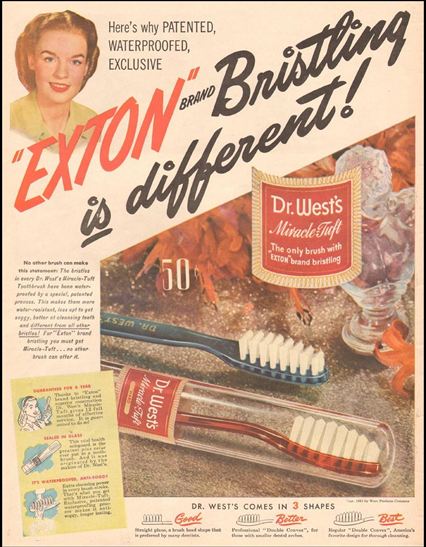
August 1938 Life magazine advertisement for first nylon bristle toothbrush.
“Until now, all good toothbrushes were made with animal bristles,” noted a 1938 Weco Products advertisement in Life magazine. “Today, Dr. West’s new Miracle-Tuft is a single exception. It is made with EXTON, a unique bristle-like filament developed by the great DuPont laboratories, and produced exclusively for Dr. West’s.”
Guaranteed for “no bristle shedding,” and selling for 50 cents ($10.96 in 2025 dollars), the toothbrush became the first commercial use of nylon.
February 25, 1918 – Pawnee Bill’s Oklahoma Oil Companies
As World War I neared its end, Gordon William “Pawnee Bill” Lillie entered the oil business in Yale, Oklahoma. Despite not being as famous as his Wyoming friend Col. William F. “Buffalo Bill” Cody, Lillie was a widely known showman and promoter of his state.
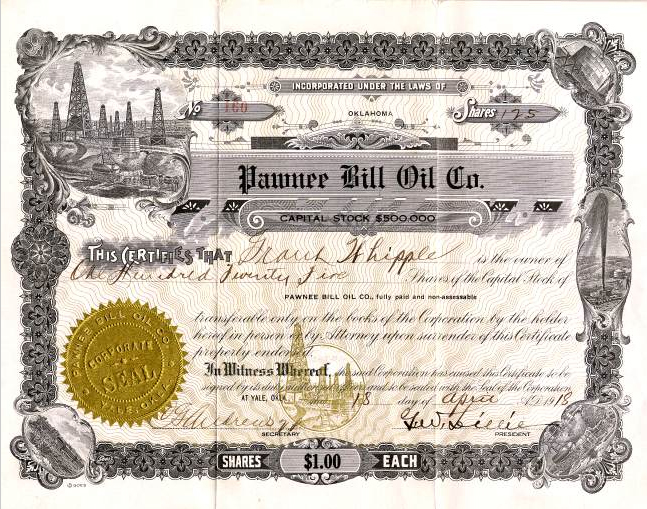
Although most are only family keepsakes, some old oil company certificates are valued by collectors.
During World War I, the Pawnee Bill Oil Company operated a refinery in Yale and leased 25 railroad tank cars. After the war, reduced demand for refined petroleum products, forced the company to operate at half capacity as other Oklahoma refineries began closing.
Although his oil exploration company remained, Pawnee Bill had to shut down his Yale refinery in March 1921. A decade earlier, friend and fellow western showman Col. William Cody had unsuccessfully searched for Wyoming oil (see Shoshone Oil Company).
Learn more in Pawnee Bill Oil Company.

February 25, 1919 – Oregon enacts First Gasoline Tax
Oil was selling for just $2 a barrel when Oregon enacted the one-cent gas tax to be used for road construction and maintenance. It was the first U.S. state to impose a gasoline tax. Less than two months later, Colorado and New Mexico followed Oregon’s example.
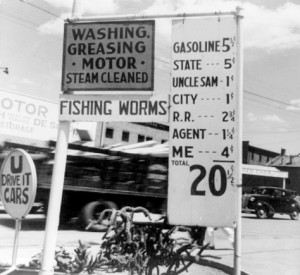
A circa 1930s service station owner explains why gas costs 20 cents a gallon in this Library of Congress photo.
By 1930, every state would add a gasoline tax of up to three cents per gallon. Faced with a $2.1 billion federal deficit, President Herbert Hoover tacked on another one-cent per gallon federal excise tax in 1932.

National average tax rates have remained steady with gasoline taxes increasing in seven states and decreasing in six, according to the Department of Energy.
In August 2024, federal taxes included excises taxes of 18.4 cents per gallon on gasoline and 24.3 cents per gallon on diesel fuel, according to the Energy Information Administration (EIA). State-imposed gasoline taxes have varied from a low of 8.9 cents per gallon (Alaska) to a high 69.8 cents per gallon (California). The federal tax of has not changed since 1993.
February 25, 1926 – Wyatt Earp’s California Oil Wells
A Kern County, California, oil well invested in by former lawman Wyatt Earp began producing 150 barrels of oil a day, confirming his belief in the field five miles north of Bakersfield. As early as 1901, drilling by the Shasta Oil Company had stirred local excitement, but the company went bust after three dry holes. In July 1924, Getty Oil Company began drilling on the Earp lease.

Wyatt Earp portrait, circa 1887.
“Old Property Believed Worthless for Years West of Kern Field Relocated by Old-Timer,” declared the San Francisco Examiner, describing Earp, 75, as the “pioneer mining man of Tombstone.” The newspaper also reported, “Indications are that a great lake of oil lies beneath the surface in this territory.”
Working on his memoirs, Earp turned over management of his oil properties to his sister-in-law, and his wife noted, “I was in hopes they would bring in a two or three hundred barrel well. But I must be satisfied as it could have been a duster, too.”
Learn more in Wyatt Earp’s California Oil Wells.
February 27, 1925 – Congress passes Osage Indians Act
As a result of murders and a “reign of terror” in the Osage Nation, the U.S. Congress passed the Osage Indians Act of 1925, prohibiting non-Osages from inheriting headrights of tribal members possessing more than one-half Osage blood. The Osage people’s sudden wealth from oil royalties (see Million Dollar Auctioneer) had brought criminal conspiracies to the Oklahoma Indian Reservation with dozens of Osage killed for the headrights to their land.
February 27, 1962 – California Voters approve Offshore Drilling
Voters in Long Beach, California, approved the “controlled exploration and exploitation of the oil and gas reserves” underlying their harbor south of Los Angeles. The city’s charter had prohibited drilling there since a 1956 referendum, but advances in technology offered new and environmentally sensitive opportunities to exploit an additional 6,500 acres of the Wilmington oilfield.

Los Angeles Association of Professional Landmen members toured THUMS in 2017. Photo courtesy LAAPL.
Four artificial islands were soon constructed at a cost of $22 million by a consortium of companies called THUMS: Texaco (now Chevron), Humble (now ExxonMobil), Union Oil (now Chevron), Mobil (now ExxonMobil) and Shell Oil. The islands in 1967 were named Grissom, White, Chaffee, and Freemen in honor of lost NASA astronauts. Occidental Petroleum purchased THUMS in 2000.
Eventually operated by the California Resources Corporation, the four “Astronaut Islands” are designed to appear to be occupied by upscale condominiums, thanks to Disneyland architect Joseph Linesch, whose integration of oil production structures the Los Angeles Times described as “part Disney, part Jetsons, part Swiss Family Robinson.”
Learn more in THUMS – California’s Hidden Oil Islands.

February 28, 1935 – DuPont Chemist invents Nylon
A former Harvard professor working in a DuPont research laboratory discovered the world’s first synthetic fiber, the petroleum product nylon. After experimenting with artificial materials for more than six years, professor Wallace Carothers created a long molecule chain — a stretching plastic. The inventor earlier discovered neoprene (commonly used in wetsuits).

Carbon, hydrogen and oxygen atoms strung in a chain create manmade fibers used for textiles and plastics. Each molecule contains six carbon atoms.
Carothers produced the fibers when he formed a polymer chain using a process to join individual molecules. Each molecule consisted of 100 or more repeating units of carbon, hydrogen and oxygen atoms, strung in a chain. DuPont patented nylon in 1935, but it was not revealed until 1938.
Originally called “Fiber 66,” the polyamide resulted from 12 years and $27 million in research. Several marketing names were considered for the “artificial silk,” before nylon was chosen. The first commercial use was for toothbrush bristles. After World War II, nylon hosiery for women would make a fortune for the Delaware chemical company.
Learn more in Nylon, a Petroleum Polymer.
February 28, 1982 – Getty Museum becomes Richest in World
Following years of legal battle by his relatives, the J. Paul Getty Museum in Los Angeles became the most richly endowed museum in the world after receiving a $1.2 billion bequest left to it by oil billionaire J. Paul Getty, who died in 1976.

The J. Paul Getty Museum opened in Los Angeles in 1954. The museum’s art collection today is housed at the Getty Center (above in 2009) and the Getty Villa on the Malibu coast.
After working in his father’s oilfields in Oklahoma, Getty founded his first oil company in Tulsa and drilled the Nancy Taylor No. 1 well near Haskell, where oil and natural gas production began in 1910. Getty’s oil wealth philanthropy also established the Getty Conservation Institute and the Getty Research Institute, according to the J. Paul Getty Trust.
March 1, 1921 – Halliburton improves Well Cementing
Erle P. Halliburton patented his “Method and Means for Cementing Oil Wells,” improving a key oilfield technology. “It is well known to those skilled in the art of oil well drilling that one of the greatest obstacles to successful development of oil bearing sands has been the encountering of liquid mud water and the like during and after the process of drilling the wells,” he noted in his patent application.

The Halliburton 1921 cementing process isolated geologic zones while protecting casing integrity.
Halliburton’s well cementing process isolated downhole zones, guarded against collapse of the casing, and allowed control of the well, helping to protect the environment. His patent application noted that typical oil production, “hampered by water intrusion that required time and expense for pumping out…has caused the abandonment of many wells which would have developed a profitable output.”
In March 1949, Halliburton Oil Well Cementing Company and Stanolind Oil completed the first commercial application of hydraulic fracturing at a well near Duncan.
Learn more in Halliburton cements Wells.

March 2, 1922 – Lease sells for $1 Million in Osage Nation
Under the broad crown of a giant elm next to the Osage Council House in Pawhuska, Oklahoma, Skelly Oil and Phillips Petroleum Company jointly bid more than one million dollars for a 160-acre tract of land.

Colonel Elmer Ellsworth Walters (in the striped shirt) was famous as “auctioneer of the Osage Nation.”
The 1922 auction — Oklahoma’s first million dollar mineral lease — took place in the shade of what became known as the “Million Dollar Elm.” Independent producers such as Frank Phillips, Harry Sinclair, Bill Skelly, J. Paul Getty and E.W. Marland were frequent bidders for promising leases. The Osage would erect a statue of their auctioneer, Colonel Elmer Ellsworth Walters, in his hometown of Skedee.
Learn more in Million Dollar Elm.
_______________________
Recommended Reading: Enough for One Lifetime: Wallace Carothers, Inventor of Nylon (2005); Pawnee Bill: A Biography of Major Gordon W. Lillie (1958); Wyatt Earp: The Life Behind the Legend
(1958); Wyatt Earp: The Life Behind the Legend (2012); Black Gold in California: The Story of California Petroleum Industry
(2012); Black Gold in California: The Story of California Petroleum Industry  (2016); Du Pont Dynasty: Behind the Nylon Curtain
(2016); Du Pont Dynasty: Behind the Nylon Curtain (1984); The Great Getty: The Life and Loves of J. Paul Getty – Richest Man in the World
(1984); The Great Getty: The Life and Loves of J. Paul Getty – Richest Man in the World (1986); Erle P. Halliburton, Genius with Cement
(1986); Erle P. Halliburton, Genius with Cement (1959); The Osage Oil Boom
(1959); The Osage Oil Boom (1989). Your Amazon purchases benefit the American Oil & Gas Historical Society; as an Amazon Associate, AOGHS earns a commission from qualifying purchases.
(1989). Your Amazon purchases benefit the American Oil & Gas Historical Society; as an Amazon Associate, AOGHS earns a commission from qualifying purchases.
_______________________
The American Oil & Gas Historical Society (AOGHS) preserves U.S. petroleum history. Please become an AOGHS annual supporter and help maintain this energy education website and expand historical research. For more information, contact bawells@aoghs.org. Copyright © 2025 Bruce A. Wells. All rights reserved.
by Bruce Wells | Jul 20, 2024 | Petroleum Pioneers
Oil boom 1920s lease auctions earned the Osage millions.
By the 1920s, Oklahoma’s petroleum exploration leases auctioned in the shade of a “Million Dollar Elm” brought prosperity to the Osage Nation. Production from Osage County alone launched the careers of Frank Phillips, J. Paul Getty, Bill Skelly, E.W. Marland, Harry Sinclair — and Clark Gable.
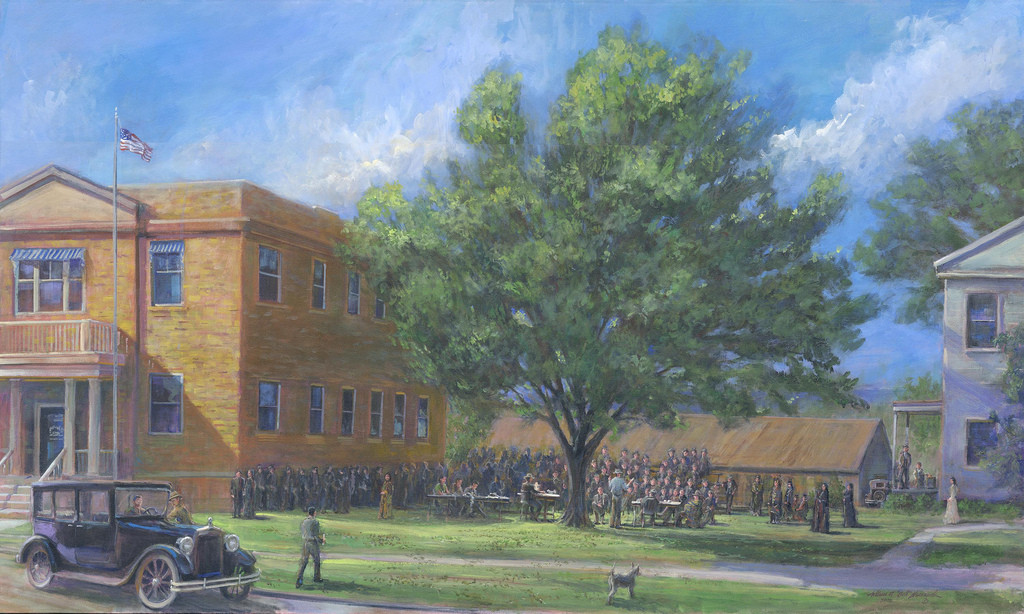
A circa 1920s painting depicts one of the many lease auctions that took place under the “Million Dollar Elm” next to the Osage Nation tribal council house in Pawhuska, Oklahoma.
In the spring of 2003, the Osage nation opened a “Million Dollar Elm” casino a few miles from its council house at Pawhuska, Oklahoma. The name came straight from Osage reservation petroleum history. Multi-million dollar lease auctions took place in the shade of a giant elm next to the council house.
Osage County, at more 2,250 square miles, is the largest county in Oklahoma – larger than Delaware or Rhode Island. On the grounds atop Agency Hill between the county courthouse and the Osage tribal council house, today stands a symbolic elm where auctions regularly took place on hot summer afternoons.

Soon after Oklahoma statehood, more Osage discoveries brought thousands to Bartlesville, Hominy, Fairfax, Grainola and Burbank. All the oilfields produced a high-quality, easily refined oil. First drilled in 1920, the Burbank field and several others soon became one of the richest in Oklahoma.
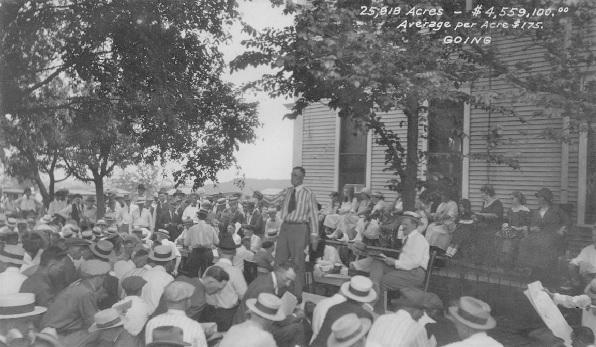
Colonel Elmer Ellsworth Walters, official auctioneer of the Osage Nation (seen here on June 14, 1921), sold millions of dollars of oil leases in the shade of an elm tree. Photo courtesy Bartlesville Area History Museum.
At its peak, the Burbank oilfield produced more than 70,000 barrels a day from more than 1,800 wells. Phillips Petroleum made a fortune there. Other petroleum companies got their start in Osage oilfields, including Conoco (originally Marland Oil), Skelly Oil, Carter Oil (later incorporated into Standard Oil), and Gypsy Oil Company (later Gulf).
Traces of oil had long been noted in the area, including slicks on creeks and oil seeps. The southern end of the Flint Hills, which ranges down from Kansas, has rocks 298 million years old, according to Jenk Jones Jr. of the Tallgrass Prairie National Preserve in Cottonwood Falls, Kansas.
The Indian Territory Illuminating Oil Company made the first drilling deal with the Osage Tribe, he noted in 1991. The oil company received rights to all drilling in the Osage Nation for 10 years, beginning in 1896. The next year the territory’s first commercial producer was completed, the Nellie Johnstone No. 1 well, in what is now a park in Bartlesville.
All of Osage County was open for bidding after 1916 – just in time for the greatest years of the Osage boom, triggered by demands of World War I and the postwar growth in automobiles.
“To get a sense of how the oil business exploded in the Osage, there were about 6,000 barrels produced in 1900, more than 11 million in 1914. The Osage boom and a vast leap in the number of automobiles coincided remarkably well,” Jones explained in a Tulsa World article.

Colonel Walters on March 2, 1922, sold a million-dollar 160-acre oil lease for the Osage Nation. Walters auctioned another 160-acre Osage lease for $2 million in 1924. Detail of photo in Oil! Titan of the Southwest by Carl Coke Rister, 1949.
During the height of the drilling boom from 1919 to 1928 northwest of Tulsa, more than $202 million was paid to the tribe in oil and natural gas royalties, bonuses, interest and land rentals.
“The Osage fields were an oilman’s dream,” reported Jones. “The oil was a high-grade, with a good conversion to gasoline ratio. It was easily refined, with a very high percentage of kerosene. It was free of sulfur and asphalt.”
According to Corey Bone of the Oklahoma Historical Society, the profitable auctions of Osage mineral rights were based on “headrights” from a 1906 tribal population count.
“Unlike other landholders, the Osage were able to retain collective ownership of subsurface mineral rights, rather than having to accept allotments to individual owners,” Bone explained. “Instead, tribal members received ‘headrights’ that assured them an equal share of mineral rights sales equivalent to income from 658 acres.”

She added that a headright could not be sold, but an individual could sell his or her surface rights. “An average Osage family of a husband, wife, and three children would receive more than $65,000 a year in 1926,” Bone noted.
By 1939, Osage individuals had received more than $100 million in royalties and bonuses.
Million Dollar Auctioneer
Great petroleum wealth for the Osage people brought criminal conspiracies — and the murder of Osage for headrights to their land. The murders eventually led to an FBI investigation, convictions — and changes to the law in 1925.
When the “Reign of Terror” news finally made national headlines, it obscured the the good work of a longtime friend and respected auctioneer of the tribe’s leases. The Osage would erect a statue to their auctioneer, Colonel Elmer Ellsworth Walters, in his hometown of Skedee.
Born in at the end of the Civil War in 1865, his parents had named him after the first Union martyr of the Civil War, Col. Elmer Ellsworth of the 11th New York Volunteers. His friendship helped earn the Osage millions of dollars (learn about Walters, his leases auctions, the dark history of Osage headrights in Million Dollar Auctioneer.
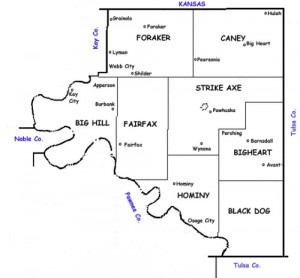
Map of Osage County, Oklahoma, townships courtesy OKGenWeb.
As the auctioneer for the Osage, Walters worked for about $10 a day, beginning in 1912. Later, surrounded by bidding oil company owners E.W. Marland, William Skelly and the Phillips brothers, he regularly set new lease sales records.
Walters would become greatly admired among the Osage of Pawhuska. “He knew the oilmen intimately and was an expert at getting them to raise bids,” Jones explained. “So subtle were their signals that L.E. Phillips reportedly ‘bid’ $100,000 for a lease by brushing a fly away from his nose.”
The elm’s name was not given by tribal leaders – but by reporters and magazine writers who were dramatizing the events when founders of the world’s greatest oil companies came in person to bid. It truly earned its name when 18 tracts brought bonuses of $1 million on a single day, November 11, 1912.
Auctions by Walters would earn about $157 million for the Osage tribe by 1928, two years after the Osage Nation dedicated a statue to their auctioneer, Colonel Elmer Ellsworth Walters, in his hometown of Skedee. The statue depicts the auctioneer shaking hands with his friend Osage Chief Bacon Rind.
Osage Oil Boom
A large cast of national characters are linked to petroleum exploration and production on the Osage Nation. Future president Herbert Hoover, an orphan, spent summer months in Pawhuska after his uncle Major Lahan J. Miles was appointed agent to the Osages in 1878.
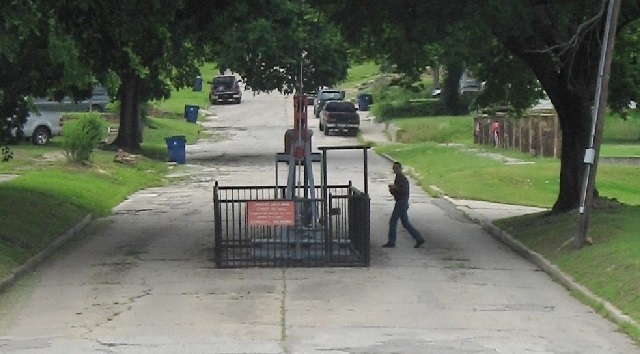
Visitors to Barnsdall, Oklahoma, can view a registered petroleum landmark in the middle of Main Street that is considered to be the only such oil well in the world. Photo by Bruce Wells.
Southeast of Pawhuska, the town Pershing was an oil boom town named for Gen. John J. Pershing, leader of U.S. forces in Europe during World War I.
Tom Mix, future silent film star, was a town marshal in Dewey just east of the Osage County border. The Wild West show of the 101 Ranch in Kay County west of the Osage gave him the boost that sent him to Hollywood.
Clark Gable worked as a roustabout in the Osage oilfields, especially around Barnsdall and Pershing, before heading to California for stardom (see Boom Town Burkburnett).

Memories of what took place beneath the Osage Nation elm did not fade after the original tree died in the 1980s. The latest elm, dedicated during a September 15, 2006, ceremony, grows new roots into the historic site. Visitors gamble at six Osage Nation “Million Dollar Elm” casinos.
In 2011, Oklahoma City-based Chaparral Energy reportedly began working on methods to increase production from Osage oilfields that could bring $11 billion to Osage County and provide the Osage Nation with $1.2 billion in royalty payments over the next 30 years.
Editor’s Note: Special thanks to Jenk Jones Jr. and his March 1, 2003, “Osage County History” docent orientation presentation, Tallgrass Prairie National Preserve, Cottonwood Falls, Kansas.
_______________________
Recommended Reading: The Underground Reservation: Osage Oil (1985); Oil in Oklahoma
(1985); Oil in Oklahoma (1976); Killers of the Flower Moon (2018). Your Amazon purchase benefits the American Oil & Gas Historical Society. As an Amazon Associate, AOGHS earns a commission from qualifying purchases.
(1976); Killers of the Flower Moon (2018). Your Amazon purchase benefits the American Oil & Gas Historical Society. As an Amazon Associate, AOGHS earns a commission from qualifying purchases.
_______________________
The American Oil & Gas Historical Society preserves U.S. petroleum history. Please become an AOGHS annual supporter and help maintain this energy education website and expand historical research. For more information, contact bawells@aoghs.org. © 2025 Bruce A. Wells. All rights reserved.
Citation Information – Article Title: “Million Dollar Elm,” Authors: B.A. Wells and K.L. Wells. Website Name: American Oil & Gas Historical Society. URL: https://aoghs.org/petroleum-pioneers/million-dollar-elm. Last Updated: April 20, 2025. Original Published Date: March 24, 2014.






(1985); Killers of the Flower Moon: The Osage Murders and the Birth of the FBI
(2018); Colonel E. Walters: Auctioneer for the Osage Lease Sales During the early 20th-Century (2019). Your Amazon purchase benefits the American Oil & Gas Historical Society. As an Amazon Associate, AOGHS earns a commission from qualifying purchases.



















